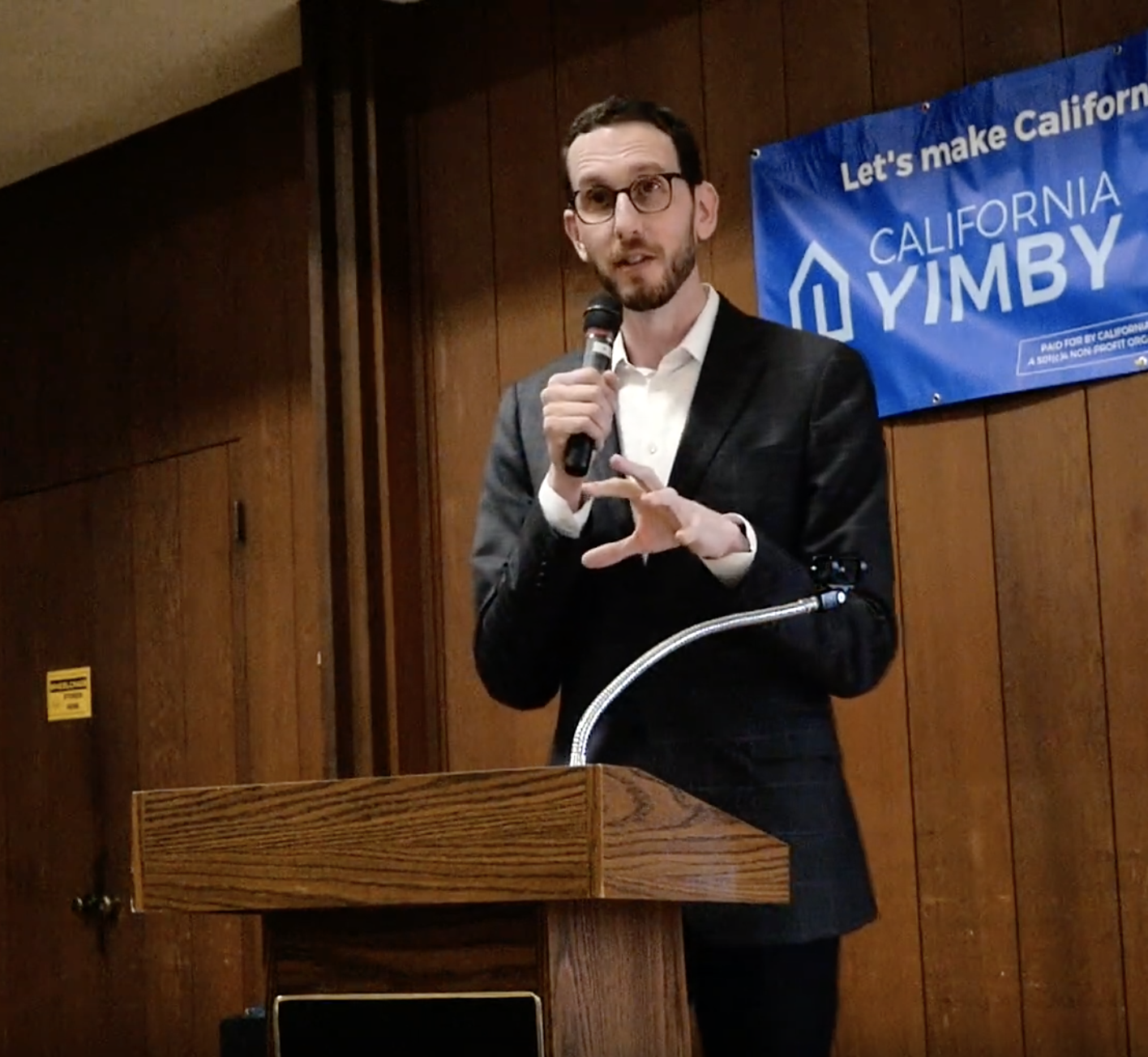California State Senator Scott Wiener visited Santa Cruz on April 5, 2019 to give a talk about Senate Bill 50 (SB50). SB50 seeks to increase the amount of new housing construction in California by up-zoning residential property located near mass transit or “job-rich” areas. This law would override local planning and zoning ordinances, which have worked to keep density low in most areas of the state. We have recorded Senator Wiener’s remarks and transcribed them if you’d prefer to read them.
See also: Vox article about SB50, Curbed LA article, Livable California on SB50
Senator Scott Wiener SB50 Presentation Video
Senator Scott Wiener SB50 Presentation Transcription
Good evening, and thank you for having me today. I really appreciate the invitation, it’s really great to be back in Santa Cruz. People sometimes say when they see me in different parts of the state, “Are you running for office statewide?” And the answer is no, absolutely not. I love representing San Francisco and San Mateo County, but I think it’s incredibly important when you’re, at a state level, making policy for the state, to be present and to talk to people in different parts of the state and to try to understand what’s going on around the state. We have a lot of commonality in California, a lot of common problems, but it’s just good to really talk to the community, so thank you for having me.
I also just want to say thank you for sending two fantastic representatives to the legislature, in Bill Monning and Mark Stone. I work with both of them a lot. It’s true, I’m not just saying this because I’m in Santa Cruz, they are two of the most thoughtful legislators that I’ve worked with and I really want to say thank you. And it’s great to have my good friend John Laird here tonight.
I think a lot times when it comes to housing, we get caught up with a lot of lingo and technical terms. We have our debates, and these terms they’re important, talk about things like zoning and CEQA and streamlining, local control and state control, and housing elements, and RHNA, and all these terms of art about housing, fair wage, project labor agreements. These terms are of course important, but I always try to encourage people when we’re talking about housing not to get too caught up in these terms and to take a step back and look at the human side of housing. Because that’s what it’s about.
It’s about the real live human beings living in Santa Cruz or Los Angeles or San Francisco or Eureka, where ever else, who are struggling with housing. I’m one of the lucky ones. I was fortunate enough, I’m pushing 50, and I was working out the back of my 30s to be able to purchase a small condo in the Castro, my neighborhood in San Francisco. I feel very lucky. But there are a lot of people who are not so lucky, and that’s what this is about. When we look at the fact that one in 20 school children in the state of California is homeless. One out of 20. That should be I think [inaudible 00:03:07] all of us, is a moral outrage. In Santa Cruz County it’s over 8%, in Monterey County it’s 10%. One out of ten or even more CSU students is homeless. I saw a recent study estimating that statewide 19% of community college students are homeless.
We have this huge and growing homeless population overall. Including, a rapidly growing, I believe the fastest growing demographic is seniors, of homeless people. And by far the largest number of unsheltered homeless in the country. We are, half of all unsheltered homeless people live in California. We have a situation where, because of our approach to housing over the last 50 years, where we’ve deprioritized it, and not built nearly enough housing, we have young people who are simply unable to get a foothold. Young people who can’t envision a future for themselves in our community, because they can’t envision a scenario where they will have stable long term housing.
We have young families who, maybe they can make a go of it when they have the first kid who’s six months or one year old, but once that kid is running around, and once they have a second kid, they’re out. Because there’s nowhere for them in terms of having adequate housing for a growing family in their community that they can even hope to afford, and so they leave. We have people being evicted and displaced. Having to leave their community because there is nowhere where they can possibly hope to afford.
This is a real problem just for the basics of existing as a human being in a community. Having actual housing, because we don’t have enough of it. There are also the economic and environmental consequences of our approach to housing. When we look at the sprawl, sprawl has been an instrumental part of California housing policy in past 50 years. We’ve announced, we’re not gonna let you build enough housing near jobs, near transit, in the urbanized areas, so you just build further and further out, cover up the farm land, cover up the open space, clog the freeways, increase carbon emissions, and we are undermining our own climate goals with the 40% carbon emissions and growing from transportation.
Then of course the economic side of it. Sometimes people say, “We want the tech companies to go away.” Or, “There’s too many jobs.” I hear that, too many jobs. I’ll tell you, over time, we’re gonna see a natural pushing away of jobs, not because people are saying please go away, but because employers increasingly are choosing not to expand to California, not because of the taxes, not because of the regulations, but because their workers can’t find housing.
In San Francisco, there was recently a very very popular, excellent restaurant called Farmer Brown, that closed down. Not for lack of business, not for poor quality of food, not for taxes, but because they couldn’t maintain a work force. They could not hire enough servers and cooks and keep them, because they couldn’t afford housing. We’re starting to see that happen and that’s in San Francisco now, but trust me San Francisco is the tip of sword in a bad way when it comes to housing. What we see in San Francisco starts to happen elsewhere, and we’re seeing that already. For these small businesses and other businesses, that’s a problem.
How did we get here? How do we get to the point where in California we have a 3.5 million home deficit, we are short 3.5 million homes, which put that in context, if you take the other 49 states combined and add up their housing deficits, it’s just about 3.5 million homes. Our housing deficit in California is approximately equal to the other 49 states combined. That is extraordinary. How did we get here?
We got here, not because, sometimes people like to demonize local elected officials, or demonize people who have opinions about what happens in their neighborhood. This is not about demonizing. We’re all subject to criticism for anything we do, whether we’re someone who’s testifying at a planning commission meeting or we’re a city council member. It’s not about that. It’s about a system, frankly, that is designed to not produce enough housing. A system that is designed to fail, and that is failing, but we can fix it.
This system that we have of how we approach housing in California was mostly set up, was mostly created in the ’60s, ’70s, and ’80s. Well let’s look, 1960 California had 15.5 million people, 1970 it had about 20 million people, 1980 it had about 23, 24 million people. That’s when we created the modern California approach to housing. We have 40 million now, we’re heading toward 50. That system that we set up for a dramatically smaller state is as follows. Even though cities have always had control over zoning in California, until the 1960s, zoning was very permissive in most places. There was not, for the most part, restrictive zoning that said you can only build one kind of housing, single family homes, that’s the only thing you’re allowed to build.
And you see in a lot of parts of the state, in LA and San Francisco, all over the state, it built in the first half of the 20th century, until the ’60s or ’70s, all sorts of types of housing. Single family homes, apartment buildings, three unit buildings, seven, 20 unit buildings all over. And then, starting in the 1960s and into the ’70s and the ’80s, cities across California down zoned, and said, “We’re not gonna let you build apartments anymore. We’re gonna ban all forms of housing except for single family homes or maybe two unit buildings.” To the point where, in San Francisco, little San Francisco, this major job center, 70% of the land in San Francisco is zoned either single family or two unit. It’s illegal to even build a three unit building in 70% of San Francisco.
The same is true in Los Angeles, and the same is true in many parts of the state. In fact, 80% of the residentially zoned land in California is zoned single family, or maybe some of it two unit. That didn’t just happen, it happened for the most part a hundred years ago, that wasn’t like ingrained into the DNA of California from 1850. That was instituted in the ’60s, ’70s, and ’80s. It happened mostly in San Francisco in the ’70s, early ’80s. In LA it happened I believe in 1985, I don’t know when it happened in Santa Cruz, I’m sure someone can figure that out, but, it happened. When we had a lot fewer people.
We also, in the early ’70s, passed a law called CEQA, that Ronald Reagan signed. CEQA’s incredibly reformed law. Some people want to get rid CEQA and blame CEQA for everything. I’m not one of those people, I think CEQA serves incredibly important purposes. But over time, CEQA was deemed to apply to infill housing in urbanized areas, where in the court interpretation saying that if you’re building some four unit apartment building next to a subway station, CEQA applies to that, and you can get sued under CEQA, and so forth. On top of that, boards and cities will sometimes say, “Well, we have to change CEQA because CEQA is hurting our ability to to deliver housing.” But of course CEQA only applies if the city decides that it’s permits are discretionary. Cities have it within their power to have ministerial permits that don’t trigger CEQA at all. But more and more cities decided to make their housing approval process subjective and discretionary with conditional use permits, and discretionary appeals. So, we would see even projects that are within local zoning, take two, three, four, five, ten years, to get approved.
That wasn’t the case in the 1950s or 1900 or in 1850. That happened starting really in the ’70s, so the new thing, when California had 15, 17 million people. So, we took all these steps in California to create the modern approach to housing in California. Hyper low density zoning, usually banning every form of housing other than single family homes, banning apartment buildings, banning affordable housing, banning senior housing, banning student housing, banning it all. Saying the only kind of home you’re allowed to build in our city or the bulk of our city is a single family home. We made that decision. You can imagine in LA, when they did that, when they down zoned, they eliminated 50%, one half of their zoned housing capacity in one fell swoop. And that’s what happened across the state. Then on top of it, we’re gonna make it really hard and expensive and long for you to get any housing approved if it’s within zoning.
So we set up this system, and maybe that system worked well when we had 15 or 20 million people in California. It doesn’t work for 40 million people, and the results are some of the results I described before. The cost of housing is driving people in poverty and into homelessness. It’s driving young families out, it’s pushing people into two hour commutes, the super commuters, who are commuting from Manteca into San Francisco, or San Bernadino into LA, and spending three and a half, four hours or more on the road every day, with the carbon emissions and messing up their back, and getting home at 9 o’clock at night when their kid’s already in bed. That’s what we’ve created, and that’s the impact.
So how do we fix it? And that’s what we’re focused on now. Again, it’s not about like, berate local elected officials. Just do your job. As a former local elected official, who understands what it’s like to get yelled at in the supermarket by someone who’s upset about a development, or a parking situation, or whatever, and I had to have a recall petition taken out against you, although I had taken out for a different reason, about public nudity in San Francisco. That was my [inaudible 00:14:50] recall [inaudible 00:14:52] it wasn’t about housing. Local elected officials are overwhelmingly people who just want to serve their community. Who overwhelmingly are not getting paid, maybe their getting paid nothing, or they’re getting paid a tiny amount of money to devote a huge part of their life to their community, and that’s why they’re in it. For the right reason.
But we have set up local governments to fail, because what we said is, “Okay, we want you to build housing. We’re gonna set housing goals for you, we’re gonna make you do planning. And guess what city council members? Every Monday afternoon or Wednesday morning or every other week when you meet, you’re gonna walk the plank, and vote for these projects, and have any of the blow back that happens as a result. And we’ve given our city council members, really, little or no cover. Because we had a system pure local control in California. Where we basically say, it’s all on you, we as a state are either going to pass no housing laws or housing laws that have no teeth, and you do it.
This form of pure local control for cities is fairly weak when it comes to housing. When you think of the issue, what are some of the issues of magnitude of housing? Housing is a huge part of human existence. Let’s talk about public education. If I came in and said I have great piece of legislation I want you to endorse, I love local control so much, that I want our school districts to be able to decide how many days a year to educate kids. If they wanna do it only 30 or 40 days a year, that’s their choice. I want them to be able to decide what subjects to teach. If they don’t wanna teach math any more, local control. I want them to decide whether they hire credentialed teachers, local control. Because they know best, they’re a local government, they should make these choices. You would laugh me out of the room, if I proposed that legislation. We can have a debate about what kind of education standards but the state plays a role and sets standards. Same with healthcare.
That’s what, in my view, we need to get to with housing. Not a state take over of local [inaudible 00:17:11]. I don’t advocate that. I don’t think that that would work. But having standards in place, and basic rules within which local control operates. To understand that housing is a statewide issue. That this 3.5 million gap, this massive gap, it’s a daunting one when you think about it. That this isn’t gonna get solved with the system that we’ve had for the last 50 years, and we will continue to set ourselves up for failure. In the end, most people who understand, because we see in the polls in California that housing and homelessness are consistently the top issues in California when you ask it in a poll. Which wasn’t the case ten years ago. It was in certain regions, but not statewide. Now it’s consistently the top two issues statewide.
Californians want to be addressed. They want their elected officials to do something about it, and to fix it. For most Californians, they don’t really care if the person who’s fixing it is the person where they checked the box next to their name on the ballot under the line city council, or mayor, or if it’s the person they voted for under the line assembly member, or senator. That’s not relevant to most people. They know that they’ve elected people to fix problems, and they want the problems fixed. For people who say the state should no role on housing, and there are even some people who are talking about a constitutional amendment to kick the state out of housing. You look at fair housing laws and other kinds of laws that the state has been criticized by local governments for in the past, we can have that debate. But the reality is, in my point of view, the state has to have a role if we’re going to fix this problem, and not have all those kids homeless living in cars or shelters, and allowing young families to actually have a chance in this state.
We are, this year, in the last few years, we have been doing, I think, some strong legislation around housing. For example, for 35 years there’s a law in California that cities are required to allow people to put ADUs or in-law units in their homes. That’s been a law since the early ’80s, and overwhelmingly cities including my own, San Francisco, have ignored that law. In the last three of four years the legislature has been putting teeth into that law, to say when we say you have to allow people to put ADUs if they want to, we mean it. We have a law also passed in the early 1980s called Housing Accountability Act that prohibits cities from arbitrarily rejecting or chopping in half or otherwise watering down projects that are within zoning, and that’s happened everywhere. The city does it’s general plan and says, “This parcel is zoned for 100 units.” Then when the project comes up, they say, “We know we said that in our zoning and our general plan, we said it was 100 units, we’re gonna let you have 27 units.” The Housing Accountability Act makes that illegal, there are no teeth in the law, we can put teeth in the law to make sure that it is enforced.
The State Density Bonus, which says to developers, if you do a certain level of affordability, you can have more density and even more height than local zoning allows. That law was passed, I think it was in the ’80s if I’m not mistaken. And in recent years it’s been strengthened because most cities are ignoring it and refusing to implement it. It’s now being implemented, and it’s generating a lot of housing and a lot of affordable housing in particular. The state is finally getting back into the business of funding affordable housing for lower income residents. For a long time the federal government was withdrawing, and California was withdrawing, including killing off redevelopment, which was abused in some instances, but was also in many places creating a lot of affordable housing. In the last few years we’ve significantly increased the state investment in affordable housing, because it’s not enough to just tell cities you shall build affordable housing, we need to partner with cities and provide that funding.
I think we need to understand that while larger cities often have a big planning department and can do all of the work that needs to be done to update general plans, to update zoning, to have objective design standards and so forth, a lot of smaller cities in California don’t have those resources, may only have a planning department of one person. May not have any capacity to do that work. The state is no providing significant funding to smaller cities to help them beef up their planning operations to be able to do goo planning work.
I think this year we may finally see some progress in increasing tenant protections in California. The legislature has not been a hospitable place to pro-renter pieces of legislation, for a long time. I think there’s finally momentum to do something and move the dial because so many renters in the state, up and down the state, are struggling and getting hit with massive rent increases. It’s not just in apartments, a significant percentage of single family homes in California are renter occupied. These renters need more protections.
We are doing more and more streamlining in California, to say that projects, the housing, should move faster, the approval should not be taking years and years and years. A bill that I authored in 2017, Senate Bill 35, that provides that for communities that are not meeting their RHNA goals, their housing goals. They become streamlined, meaning they can do executive design review, but they have to approve the project. And we were able to get good environmental and labor support for that bill, and it is turning into a real engine for affordable housing approval in particular.
And then, yes, we are looking at zoning reform, and that is Senate Bill 50, which, I don’t want to say I’m authoring, we’re authoring. We have 16 coauthors of the bill. My name is first, but there are 15 other members for every region of the state. From north to south, for coast to inland, we have both democrats and republicans, senators and assembly members. A broad cross section of the legislature ranging from some of the most lefty democrats to the most conservative republicans, because housing is not a partisan issue. I’ve learned that first hand. That there are democrats and republicans on both sides of this issue. This is an issue that affects red districts and blue districts and purple districts equally, and we all have to work together.
Senate Bill 50 will set basic zoning standards in areas near public transportation and job centers to get at that issue that I mentioned before, where we had bans, all housing other than single family homes even at job and transit centers. That is a way of ensuring that we’re not gonna fill that deficit, and that’s good [inaudible 00:25:07] we do, we’re gonna do it by sprawl. Building in wildfire zones, farm land, et cetera. The bill, there’s been a lot of misunderstanding about some aspects of the bill. The bill largely preserves local control, individual projects will continue to go through the same approval process they go through today. Conditional use, CEQA, whatever the case may be. Cities will continue to be able to have their own design review standards. Cities can continue to restrict demolitions in whatever way they choose. Cities can continue to require whatever impact fees they have in place. Local height limits will mostly apply, around bus stops and job centers it defers to local height limits, and local set back rules will apply.
But in one respect this will change local practice, and that is if you’re within a half a mile of a fixed rail or ferry stop, if you’re within a quarter mile of a high frequency bus stop, has to run frequently from six A.M. to ten P.M. during the week and on the weekends from, I believe it’s eight to eight. And in jobs centers you can’t limit density, you can’t see we’re gonna put a cap on the number of units. The cap will be dictated by the building code, which puts a natural limit on density. The bill also provides that within that half mile radius around rail or ferry, the height limit can’t be pushed below either four stories or five stories. In a lot of communities, there’s already a 40 foot or even a 50 foot height limit, and if it’s a 30 foot height limit, then you’re talking about a one or two story increase.
We have taken a lot of input, constructive feedback over the last year, and made a lot of changes to the bill. There used to be an eight story option, we took that out. We made bus stops subject to local height limits, that was a change as well, in response to feedback about buses. We put much stronger tenant protections in the bill this year. If there’s been Ellis Act eviction on the property in the last 15 years, the bill doesn’t apply to that property. If a tenant has resided on the property at any point in the last seven years, you can’t demolish it under this bill, to build a new building. We don’t want this to become a way of evicted tenants in order to build new housing.
The bill also defers to local inclusionary. In any city that has an inclusionary housing ordinance to require X percentage of the units have to be affordable to low income people, this will result in increase in those below market rate affordable units, because if you have low density zoning on the parcel, you will have no affordable housing there, because it will trigger your inclusionary ordinance, there’s no such thing as a below market rate single family home, or it’s extremely rare if there is. But now you can build a small apartment building, it will trigger your inclusionary ordinance. It will allow 100% affordable projects to be built in more places, because single family zoning you can’t build affordable housing there, if it’s multiunit, you can.
So, the legislation will have a lot of benefits, I know there’s a lot of conversation and controversy around it, and frankly, whatever side people fall on, I hope that everyone is on some level happy that we’re finally having an intense conversation about it. And this is an intense and hard conversation, but it matters. It matters. And if people are now having arguments, arguments are often a healthy thing when it comes to important issues, I’m hopeful that we come out in a better place.
We have a new governor who has made clear that housing is among his top top top priorities. I think we’re gonna see some good things come out of the legislature this year. I look forward to working with folks in Santa Cruz and other parts of the state. We’ll continue to have an open door to constructive feedback about this bill or anything else, because there are a lot of housing issues percolating in the legislature. I want to end by thanking Santa Cruz YIMBY and Santa Cruz County Business Council for hosting tonight, but I want to give a real shout out to the YIMBY movement. It’s an interesting thing because in recent years some people have taken to try and demonize the people who are YIMBYs, and all sorts of aspersions and accusations. If you’re not being attacked and criticized, it means you’re doing it right.
The reality is that I took office in local government in 2011, and in my first few years on the Board of Supervisors in San Francisco, where trust me, we have some really intense debates about development issues. We would have hearings on significant projects, and the only people who would really show up in favor of the projects were mostly people who were related to the project in some way, and maybe a couple of neighbors who thought it was a good idea. And then you would have a lot of opponents there. When the YIMBY movement started, and it did start in San Francisco but it quickly spread all over the state, all the sudden we started having people showing up at hearings, not only young people, but mostly young people.
I know YIMBYs who are in their 70s and 80s, and who are extremely passionate about the cause, but particularly young people who would show up and say, “What is my future? And What are we doing to make sure that I have a housing future here?” And that was voice that had been missing in our housing debates for so long and it’s such a welcome addition, whatever people think about any given issue, so that we can have a debate that truly reflects the broad perspectives and needs of our community. I do believe that the YIMBY movement has fundamentally changed the housing debate in California, both at the local level but also at a statewide level, and I want to say thank you to everyone who is part of that movement, and everyone who is an ally to that movement. Also thank you to everyone who might disagree with me on this idea or issue, for being involved and engaged in the process. Thank you for tonight, and I appreciate it. Thank you.
Scott Wiener SB50 Q&A
Question: How does the legislation specifically address affordable housing, not just market rate. How does SB 50 address affordable housing?
Answer:
SB 50 addresses both what we call market rate housing and affordable housing, which affordable housing means a lot of different things to many people, but when I say affordable housing I’m referring to income restricted below market rate housing. So, housing that has a subsidy in it, so it’s going to be affordable to people within a certain income spectrum, usually lower income or very low income, or extremely low income, so that they are paying no more than 30% of their income for that housing.
Market rate housing, which is sometimes dismissed as “luxury housing.” Because it’s expensive. Of course, homes that are 100 years old are also obscenely expensive right now. While there is such a thing as luxury housing, I can show you some examples in San Francisco of the hyper fancy buildings with attendants out front and personalized everything. Most of the new housing that’s going up is not luxury housing, it’s just new housing and it’s really expensive just like the old housing is because we don’t have enough of it. In my view, when you talk about the subsidized below market rate housing, and whatever you want to call it, market rate, privately produced, regular not income restricted housing, they’re both critically important.
For our low income residents, even though the market used to produce housing that affordable for low income people, it’s not right now and I don’t see that happening in the near future. Hopefully one day we’ll get back to that, but we have to have a lot of subsidized affordable housing for our low income residents because the market is not producing that housing. For our middle class, we are never, I don’t say never, we can have a total shift in our society and have socialized housing for everyone, and there are people advocating for that, and that will be a continuing discussion. In the foreseeable future, we’re not going to subsidize our way out of our middle class housing problem. It’s too big, the resources are not there, and what would end up happening is we would have resources diverted from low income to subsidize middle class.
For our middle class we’re gonna solve that problem by having a dramatic increase in the supply of housing. So we have to have both. And SB 50 does both. It will legalize significantly more housing overall by allowing more multiunit housing near transit and jobs, and it will increase affordable housing in two ways. First, as I mentioned before, let’s say you’re a city where your inclusionary housing ordinance is triggered by ten units. That’s how we do it in San Francisco, some cities it’s triggered at five, some it might be 15 or 20, but whatever that threshold is, if you have parcels that are zoned only for single family, that will never produce an affordable unit under inclusionary ordinance. If you zone down so that you can build five or ten or 15, 20 units on that parcel, it will trigger your inclusionary ordinance, so will see more affordable units under existing inclusionary ordinances.
In addition, as I mentioned before, for non-profits that are building 100% affordable housing, they can only do that if the property is zoned multiunit. Not going to build affordable single family homes. When you take parcels where affordable housing is now essentially illegal, because it’s zoned single family, and so you can build the small unit size multiunit building, that will be come a candidate for affordable housing, from 100%. That is why one of the sponsors of our bill is the Non-Profit Housing Association of Northern California, NPH. NPH is the umbrella organization for affordable housing organizations in northern California, including all or almost all of the non-profit affordable housing builders, Mercy Housing, Bridge Housing, all the non-profits that build affordable housing, they’re a part of this umbrella group called Non-Profit Housing Association of Northern California. They are one of the, not just a supporter of SB 50, they’re one of our sponsors, and they’re doing it because they know that SB 50 will result in a dramatic increase in affordable housing.
I want to just end by mentioning, I mentioned SB 35, the housing streamlining bill that I authored two years ago. The critiques that are being leveled now against SB 50, quite a few of them, are identical to the critiques that we heard about SB 35. It’s gonna be terrible for affordable housing, terrible for tenants, mass evictions everywhere, mass demolitions everywhere. It was never true. In the several years that SB 35 has been in effect, it’s resulting overwhelmingly in more affordable housing than market rate housing. I think that we’re gonna see people who are skeptical of SB 50 if it passes, always a hard road, I think are going to be pleasantly surprised with the type of housing that will [inaudible 00:38:11].
Question: a lot of questions submitted that are related to traffic and water, as you can imagine. In particular, people who are afraid that local jurisdictions know best about their limited resources. How would you respond that when you talk about the shift from local to state controls?
Answer:
I do not agree with the notion that building housing is what increases population. And the proof is in the pudding. I mentioned to you before, California, if you look at housing production in California, it basically tailed off in the 1960s. Up until the ’50s, into the ’60s we were building an enormous amount of housing, in the early ’60s California build 300,000 units of housing a year, now we build about 80,000 even though we’re a much bigger state. 300,000 units a year int eh early 1960s. So we were building a ton of housing and then we stopped. Between some point in the ’60s until pretty recently, I’m not saying, of course we were building housing in California, but it really dropped dramatically.
What happened to our population as our housing production spiraled downwards? It went from 15 million to 20 million, to 23 million, to 30 million, to 40 million today. We reduce the amount of housing that building per year by 75%, 75%. And our population is now almost three times bigger than it was in 1960. People move to California because this is by far, not the best of the fifty states, it’s the best place on Earth. It’s true in so many respects. People have been coming here for 170 years because of what California stands for, because this has been a place of innovation and creativity and risk taking and art, and you look at who’s been coming here. The LGBT … Why did I move to San Francisco in 1997 from New Jersey? And there are people who love telling me, “Go back to New Jersey.”
I moved here in 1997 to San Francisco because I was a young gay man trying to find my community. The same reason that the hippies moved here, the same reason that artists have moved here, that actors have moved here, that farmers moved here, people have moved here forever because of what California is. I’m actually inspired, I do a local art show in my office every few moths where we do a theme and we have local artists show, usually 15 or 20 local artists because we have a large space that we can do that with. It is inspiring to me that even with the average rent now in San Francisco is $3,600 a month, it’s horrible, it’s a nightmare, that the artists find a way to be there. I’m not just talking about older artists who have owned a home for 50 years, I’m talking about young people, who find a way to be here. Young people and people who are struggling, seniors who are struggling, people find a way to be in California.
Our choice is do we enough housing for them or not? In terms of our infrastructure, traffic, water, everything else, the people are already here. They’ve been moving here for a long time despite not building enough housing. Whatever strain is being put on our infrastructure, and we’re making that strain worse by the way by causing sprawl, because it’s much more inefficient to deliver water to unending sprawl than it is to do it in a concentrated area. San Francisco has the lowest per capita water use in the state, it’s half the statewide average. THat’s not just a coincidence, it’s partly because when you have that level of density. Delivering power to sprawl is more expensive, building more and more roads for sprawl is more expensive. It’s more efficient when we have infill density.
Our choice is not whether to have more population growth, people do what they’re gonna do, it’s about are we gonna have enough housing for the people, frankly, who are already here and who are already coming here. We have to do more for infrastructure. We’ve been doing, we as a state. The legislature passed the largest transportation funding measure in California history, SB 1. One of my colleagues got recalled over that vote. And that is 5.2 billion dollars a year in new funding for transportation. There’s more and more local and regional methods. We have put a lot more money into our water infrastructure as Secretary Laird notes.
We are making investments, the voters have been unbelievably generous in voting for bonds, and we have to keep doing that, but we also have to house people so that they’re not being pushed into homelessness and to other bad situations.
Question: The other common theme that we’ve heard, and you mentioned it a little bit in your talk earlier, are tenant protections. I imagine, just like SB 35 was rolled into a larger legislative package that something similar might happen with SB 50. Do you anticipate there being some kind of tenant protections passed in this year’s legislative cycle?
I will cautiously say yes. SB 50 is not in a vacuum. We need a full well rounded package. The building reform is part of that, there will be some sort of streamlining, and there are several streamlining bills that members are authoring. By the way SB 50 is my only housing bill this year, I have a shelter bill too, trying to make sure we have more shelter beds for homeless people, but Sb 50 is my housing bill. We have multiple ADU bills this year, we have various affordable housing funding bills, and we do have an aggressive package of tenant protection. We have a proposal by Richard Bloom out of Santa Monica to reform Costa Hawkins. Not to repeal it, the voters rejected repeal, but rejected Prop 10, but to reform it, so we don’t have the arbitrary 1995 cut off for rent control in California.
Assemblyman David Chiu is author a bill to put a rent gouging cap. We see people who are getting 20, 30, 40, 50, 100% rent increases in one fell swoop. This would cap that. We have several bills to create statewide just cause for eviction. We have a bill by Senator Holly Mitchell from LA that I’m coauthoring, to ban discrimination against Section 8 voucher holders. Which a number of cities already do, but we want to make sure that people on Section 8 are able to actually find housing. We have a bill by Buffy Wicks out of the East Bay, that will create a statewide rental registry, so we can actually know what our rental situation is in California. And then Senator Nancy Skinner from the East Bay has a bill to help people stay in their apartments, particularly by increasing access to legal council.
That’s a lay of the land of what’s out there. I’m under no illusion that’s all gonna pass in its pristine form. These bills are all really really hard, but I am cautiously optimistic that at least some of them will pass in some negotiated form. Governor Newsom, both during the campaign and in his State of the State he said send me tenant legislation. I think he will help broker some sort of negotiation, so I’m cautiously optimistic that we’ll get something good done for tenants this year.
Question: What can we do, both as community members and as local elected leaders to create a willingness to support more affordable housing and more housing in general?
Answer:
I think it’s really important just for people of all political views to be involved. I think it’s really hard, going to your local planning commission or city council. You meet with your elected officials, it takes a lot of time and energy, we’re all short on time. We’re working and raising kids, so it’s challenging. But it’s so important for us to hear from people. I tend to hear from a lot of people on housing, just because I do a lot of this work and people love me or hate me or somewhere in between. For a lot of members who aren’t necessarily right at the center of the housing debate, they’re not always hearing for their constituents. They’re only hearing from one side because opposition and anger is a much more powerful motivation to engage unfortunately, than, “Okay, I’m happy with what’s happening.”
Happiness, unfortunately, it’s nice to be happy, but happiness is less of a motivator to dive in and get involved and spend time at a planning commission hearing, or go see your senator or assembly member and say, “This is what I think.” And being organized. We have more and more organization, we have neighborhood associations and groups that take a certain perspective on development or other issues, we have the YIMBYs and it’s great for me when people say, “I want more housing, how can I get involved?” I say, “Just go join your local YIMBY chapter.” I didn’t know what to tell them. You have more and more people who are involved in affordable housing organizations, whether it’s non-profits that build affordable housing or organizations that help people keep their housing.
Just being involved and making your voice heard, as cliché as that sounds, it’s incredibly important. Members of the legislature, in addition to city council members, the mayors, believe me, we hear when people are rising up and saying, “This is what I think.” We hear it.
Santa Cruz County Luxury Homes For Sale
2
3
4
5
6
7
8
9
10
11
12
13
14
15
16
17
18
19
20
21
22
23
24
25










